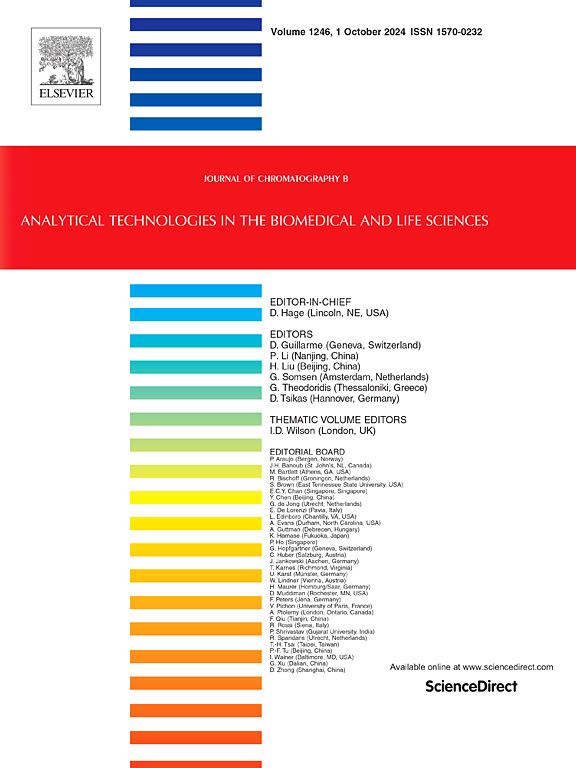UPLC-MS/MS定量人母乳中多替格拉韦、比替格拉韦、雷替格拉韦和多拉韦林的含量
IF 2.8
3区 医学
Q2 BIOCHEMICAL RESEARCH METHODS
引用次数: 0
摘要
随着使用更新和更强效的抗逆转录病毒药物,通过母乳喂养传播病毒的风险已大大降低。这导致了指南建议的改变。目前,在艾滋病毒感染得到良好控制的情况下,母乳喂养被视为配方奶的平衡。然而,尚不完全确定婴儿通过母乳接触抗逆转录病毒药物是否值得关注。关于母乳中多替格拉韦、雷替格拉韦、比替格拉韦和多拉韦林的浓度,只有稀疏和不一致的数据。因此,需要进一步的研究,并准确描述婴儿通过母乳接触抗逆转录病毒药物,需要可重复的生物分析方法。我们对edta血浆中几种抗hiv药物的UPLC-MS/MS方法进行了改进,用于验证人母乳中多替格拉韦、比替格拉韦、雷替格拉韦和多拉韦林的浓度。以[13C,2H5]-多替格拉韦、[13C,2H2,15N]-比替格拉韦、[2H6]-雷替格拉韦和[13C6]-多拉韦林作为内标。样品制备包括蛋白质沉淀和串联质谱(MS/MS)检测,总运行时间为10 min。在0.0100 ~ 10.0 mg/L的浓度范围内,多乐替韦和多拉韦林,0.00500 ~ 10.0 mg/L的浓度范围内,雷替韦和比替韦的浓度范围为0.0200 ~ 20.0 mg/L。运行内和运行间的准确度在标称浓度的±10%以内,高、中、低浓度质量控制的精密度为10cv %,±8.8%和±lt;在所有分析物的定量下限分别为14 CV%。多替格雷韦及其内标品提取率分别为81%和79%,比替格雷韦及其内标品提取率分别为83%和83%,雷替格雷韦及其内标品提取率分别为89%和92%,多拉韦林及其内标品提取率分别为104%和101%。4℃下处理14天后,母乳中多替格拉韦、比替格拉韦、雷替格拉韦和多拉韦林的含量分别为108%、95.5%、105%和102%。该检测方法目前已成功应用于药代动力学研究。本文章由计算机程序翻译,如有差异,请以英文原文为准。
Quantification of dolutegravir, bictegravir, raltegravir and doravirine in human breastmilk with UPLC-MS/MS
With the use of newer and more robust antiretrovirals, the risk of viral transmission through breastfeeding has sharply diminished. This has led to a change in guideline recommendations. Currently, breastfeeding is regarded as an equipoise of formula, in case of a well-controlled HIV infection. However, it is not yet fully established whether infant exposure to antiretroviral drugs through breastmilk is a reason for concern. Only sparse and heterogenous data exist on concentrations of dolutegravir, raltegravir, bictegravir and doravirine in breastmilk. So further research is required and to accurately describe infant exposure of antiretrovirals through breastmilk, reproducible bioanalytical methods are needed.
Our existing UPLC-MS/MS method for several anti-HIV drugs in EDTA-plasma was modified for validation of dolutegravir, bictegravir, raltegravir and doravirine concentrations in human breastmilk. [13C,2H5]-Dolutegravir, [13C,2H2,15N]-bictegravir, [2H6]-raltegravir and [13C6]-doravirine were used as internal standard. The sample preparation involved protein precipitation and detection was performed with tandem mass spectrometry (MS/MS) in a total runtime of 10 min.
The assay was validated over the concentration range of 0.0100–10.0 mg/L for dolutegravir and doravirine, 0.00500–10.0 mg/L for raltegravir and 0.0200–20.0 mg/L for bictegravir. Within-run and between-run accuracy were within ±10 % of the nominal concentration and precision <10 CV% for quality controls at high, medium and low concentrations, and ± 8.8 % and < 14 CV%, respectively, at the lower limit of quantification for all analytes. Extraction recovery was 81 % and 79 % for dolutegravir and its internal standard, 83 % and 83 % for bictegravir and its internal standard, 89 % and 92 % for raltegravir and its internal standard and 104 % and 101 % for doravirine and its internal standard. Processed samples of dolutegravir, bictegravir, raltegravir and doravirine in breastmilk were 108 %, 95.5 %, 105 % and 102 % after 14 days at 4 °C.
The assay is currently being implemented successfully in pharmacokinetic studies.
求助全文
通过发布文献求助,成功后即可免费获取论文全文。
去求助
来源期刊

Journal of Chromatography B
医学-分析化学
CiteScore
5.60
自引率
3.30%
发文量
306
审稿时长
44 days
期刊介绍:
The Journal of Chromatography B publishes papers on developments in separation science relevant to biology and biomedical research including both fundamental advances and applications. Analytical techniques which may be considered include the various facets of chromatography, electrophoresis and related methods, affinity and immunoaffinity-based methodologies, hyphenated and other multi-dimensional techniques, and microanalytical approaches. The journal also considers articles reporting developments in sample preparation, detection techniques including mass spectrometry, and data handling and analysis.
Developments related to preparative separations for the isolation and purification of components of biological systems may be published, including chromatographic and electrophoretic methods, affinity separations, field flow fractionation and other preparative approaches.
Applications to the analysis of biological systems and samples will be considered when the analytical science contains a significant element of novelty, e.g. a new approach to the separation of a compound, novel combination of analytical techniques, or significantly improved analytical performance.
 求助内容:
求助内容: 应助结果提醒方式:
应助结果提醒方式:


